The Development of Mahayana Buddhism
Additional Buddhist practices and teachings began to appear in a wide range of scriptures from the early centuries CE.
These further developments in thought and practice gradually evolved into what is called Mahayana, the Great
Vehicle. ... An early Mahayana scripture, the Lotus Sutra,
defended its seemingly innovative ideas by claiming that
earlier teachings were skillful means for those with lower
capacities. The idea is that the Buddha geared his teaching to his
audience, and that his teachings were presented in different ways and at different levels of completeness in accordance with the readiness of his audience to understand them. ...
The Lotus
Sutra and other new Mahayana scriptures also taught that there was a higher
goal than the arhant’s achievement of liberation, namely, to aspire to become a bodhisattva.
Theravada Buddhists use the term bodhisattva to refer to the Buddha in
his past lives and up to the time he attained enlightenment. Mahayana
Buddhists speak of the bodhisattva as a being who has taken a vow
to become fully enlightened in the future — a fully awakened Buddha —
and who will assist others in their liberation as they work to complete
their vow. The Lotus
Sutra says
that all beings have the capacity for Buddhahood and are destined to
attain
it eventually. Both monastics and laity are urged to take the bodhisattva vow and work to become fully enlightened. ...
The concept of the selfless bodhisattva is not just an ideal for
earthly conduct; numerous bodhisattvas are believed to be
present and available to hear the devotees’ petitions. ... The most popular bodhisattva in East Asia is Avalokiteshvara (known as Guanyin in China, Kannon in Japan), who symbolizes compassion and extends blessings to all. Although he is depicted as male in India, the
Lotus Sutra says that this bodhisattva takes whatever form is needed to
help others, and lists thirty-two examples. In East Asia, Avalokiteshvara
is typically depicted as female, often as the bestower or protector of young children. (Living Religions, 155-7)
Key Concepts of Mahayana Buddhism
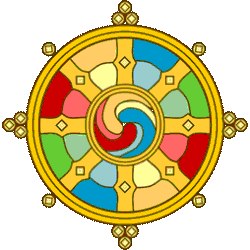
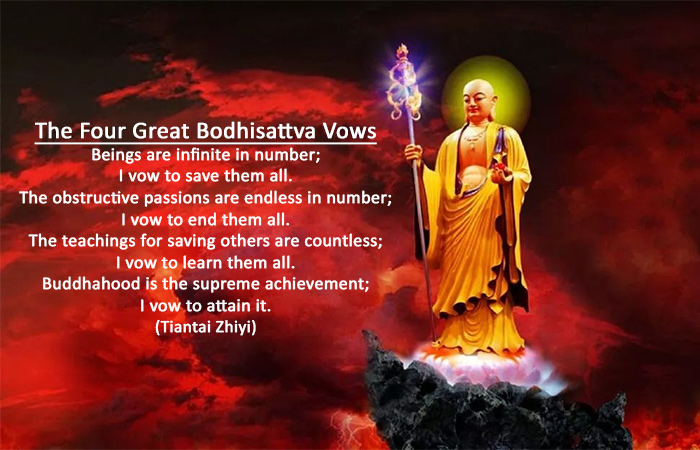 |
I. The Bodhisattva Path
The first characteristic notion found in developed Mahayana is the view that a Buddha, rather than an arhat,
is the person who can be of most help to people who are suffering and
in need of liberation. To achieve this condition of Buddhahood, one
needs to follow the Bodhisattva Path. This bodhisattva life begins with
what is called the “arising of the thought of Awakening,” or bodhicitta. This bodhicitta
is really the altruistic desire, or heartfelt aspiration, to attain
Buddhahood so that one can help others gain freedom from suffering. (BIBE, 117)

 II. The Perfection of Wisdom
II. The Perfection of WisdomA second characteristic of Mahayana teaching is the notion of a “higher wisdom” (prajnaparamita) realizing “emptiness” (sunyata).
This notion has to do with the awakened experience of the Buddhas and
bodhisattvas. For Mahayana, what one experiences with awakened
consciousness is that all the “factors of existence” (dharmas), which we have seen were so carefully analyzed in the Abhidharma Pitaka, are “empty” (sunya)
of existing independently, or “on their own.” ... This is another way of
saying what the Buddha himself taught, namely, that all things arise
dependently. To experience this dependently arisen nature of
things — their “emptiness” of independence — is the core of wisdom
experience according to Mahayana. It is this profound wisdom realizing
emptiness that, coupled with a compassionate motivation to save all
living beings, furthers one’s Great Journey to the goal of Buddhahood. (BIBE, 117)
Om!
Praise to the blessed and noble perfection of wisdom! The noble
Avalokitesvara Bodhisattva was moving in the deep journey of the
perfection of wisdom. When he looked down at the Five Aggregates, he
saw that they are empty of own-being.
Here, O Sariputra, form is emptiness, emptiness is form. Form is
not different from emptiness, emptiness is not different from form.
What is form is emptiness, what is emptiness is form. The same is true
for sensations, perceptions, mental formations and consciousness.
Here, O Sariputra, all dharmas are characterized by
emptiness; they are neither produced nor cease, they are neither
defiled nor pure, they are neither deficient nor complete. ... Therefore,
one should know the great mantra of the perfection of wisdom, the mantra of great knowledge, the unsurpassed and unequaled mantra, the mantra that allays all duhkha — it is true, for there is nothing lacking in it. By the perfection of wisdom is this mantra spoken. It is the following: Gone, gone, gone beyond, utterly gone beyond; Awakening; O joy! (BIBE, 122)
|
A
third characteristic of Mahayana teaching concerns the nature of
consciousness. We have seen that one view of consciousness found in
early Buddhist texts teaches that the mind is naturally pure and clear,
having been stained by mental defilements. While in Mahayana there are
many and sometimes conflicting notions concerning consciousness, we
find a similar strand of thought. It claims that consciousness, prior
to being affected by defilements, is the luminous clarity nirvanic
status of enlightened Buddhahood. This pure luminosity as the true
essence of consciousness gives people the potential for Buddhahood. But
ordinary conscious life generates conceptualizations and other mental
formations that frustrate this potential. In the end, it is the mind
that enslaves people in a life that is untrue and unsatisfying (duhkha); and it is also the mind that can set people free. (BIBE, 118)

 IV. Buddha Realms IV. Buddha RealmsFinally,
the fourth characteristic notion has to do with the nature of
Buddhahood, the goal of the Bodhisattva Path. While the early Buddhist
texts claim that the cosmos includes realms of hells, ghosts, gods,
and Brahma beings,
Mahayana expanded this vision of the cosmos by claiming that it also
contains countless Buddhas residing in Buddha realms. In following the
Bodhisattva Path, one can be reborn in one of these realms, where one
can progress toward Buddhahood under the guidance and with the
blessings of the Buddha of that realm. When one attains Buddhahood, one
will also create a Buddha realm from where one will help others
throughout the cosmos. In the meantime, one can receive guidance and
blessings in this world, as well as visualize these “celestial” Buddhas
and their realms and the advanced bodhisattvas that abide in them in
ways that are spiritually transforming. These Buddhas and advanced
bodhisattvas develop special skillful means (upaya)
that they use to appear in the many world systems of the cosmos in
order to help other beings become free from suffering and progress in
the journey to Awakening and Buddhahood. (BIBE, 118)

Two Approaches to Mahayana
Self Power & Other Power
|
|
“Self-Power”
The Chan/Zen Tradition
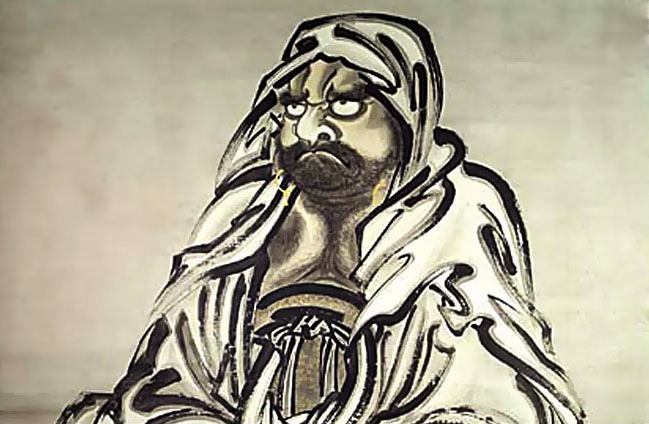 |
 Buddhism
was transmitted from India to China beginning around the first century
CE and thence to Korea, Japan, and Vietnam. The major schools of East
Asian Buddhism are part of the Mahayana branch. Many of these schools
have also absorbed elements from other East Asian religions, such as Daoism, Korean shamanic practices, and Shinto. ... Around the fifth century CE, according to tradition,
a South Indian monk named Bodhidharma traveled to a monastery in
northern China, where he reportedly spent nine years in silent
meditation, “facing the wall.” He became recognized as the first
patriarch of the radical path that came to be called Chan Buddhism,
from the Sanskrit word dhyana,
meaning meditation. Although traditional accounts of Bodhidharma’s life
and contributions may not be completely factual, they illustrate the
emphasis on meditation and direct insight that characterize the Mahayana school of Chan
Buddhism, which became the most successful form of Buddhism in China. (Living Religions, 160) Buddhism
was transmitted from India to China beginning around the first century
CE and thence to Korea, Japan, and Vietnam. The major schools of East
Asian Buddhism are part of the Mahayana branch. Many of these schools
have also absorbed elements from other East Asian religions, such as Daoism, Korean shamanic practices, and Shinto. ... Around the fifth century CE, according to tradition,
a South Indian monk named Bodhidharma traveled to a monastery in
northern China, where he reportedly spent nine years in silent
meditation, “facing the wall.” He became recognized as the first
patriarch of the radical path that came to be called Chan Buddhism,
from the Sanskrit word dhyana,
meaning meditation. Although traditional accounts of Bodhidharma’s life
and contributions may not be completely factual, they illustrate the
emphasis on meditation and direct insight that characterize the Mahayana school of Chan
Buddhism, which became the most successful form of Buddhism in China. (Living Religions, 160)
|
Zen Mind, Beginner’s Mind
Shunryu Suzuki
For
Zen students the most important thing is not to be dualistic. Our
“original mind” includes everything within itself. It is always rich
and sufficient within itself. You should not lose your self-sufficient state of mind. This does not mean a closed
mind, but actually an empty mind and a ready mind. If your mind is
empty, it is always ready for anything; it is open to everything. In
the beginner’s mind there are many possibilities; in the expert’s mind
there are few. (Zen Mind, Beginner’s Mind, 21)
What is our "original mind"?
If the "original mind" is our true mind, then how can it be lost?
How does having an "empty mind" allow us to reconnect with this "original mind"?
|
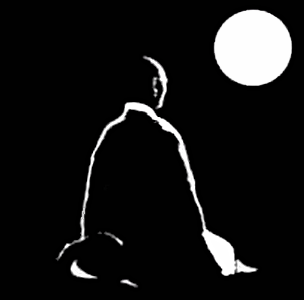 The Koan
The Koan
The word Koan
or Ko-an comes from the Chinese term kung-an, literally “public
notice,” or “public announcement.” ... Basically a Koan is a paradoxical utterance used in Zen as a
center of concentration in meditation. The paradoxical nature of Koans
is essential to their function: The attempt to break down conceptual
thought. Koans are constructed so that they do not succumb to conceptual
analysis and thereby require a more direct response from the meditator. (the-wanderling.com/mu.html)

A monk asked Joshu:
“Does a dog have Buddha Nature?”
 Joshu replied, “Mu!”
Joshu replied, “Mu!”

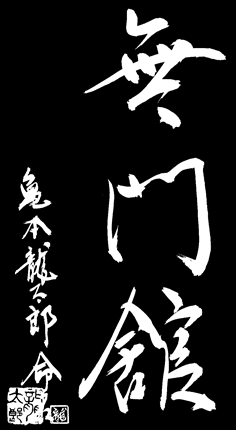
... concentrate your
whole self, with its 360
bones and joints and 84,000 pores, into Mu making your whole body a
solid lump of doubt. Day and night, without ceasing, keep digging
into it, but don’t take it as “nothingness” or as “being”
or “non-being.” It must be like a red-hot iron ball which you
have
gulped down and which you try to vomit up, but cannot. You must
extinguish all delusive thoughts and feelings which you have cherished
up to the present. After a certain period of such efforts, Mu
will come to fruition, and inside and out will become one
naturally. You will then be like a dumb man who has had a
dream. You will know yourself and for yourself only.
Then all
of a sudden, Mu will break open and astonish the heavens and shake the
earth. It will be just as if you had snatched the great sword of
General Kan. If
you meet a Buddha, you will kill him. If you meet an ancient Zen
master, you will kill him. Though you may stand on the brink of
life and death, you will enjoy the great freedom. In the six
realms
and the four modes of birth, you will live in the samadhi of innocent
play.” |
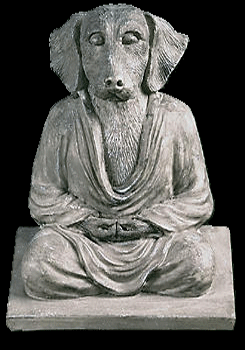
|
Mumon’s Final Verse
Dog! Buddha nature!
The perfect manifestation, the absolute
command;
A little “has” or “has not,”
And body is lost! Life is lost!
|
So ... what did the Enlightened Cat
say to the Buddha Nature Dog?
 DOUBLE-CLICK BELOW FOR ANSWER
DOUBLE-CLICK BELOW FOR ANSWER
MEW
|

|
